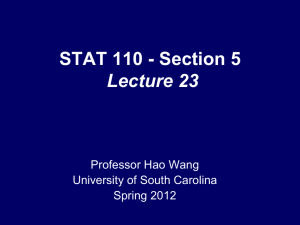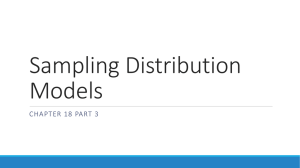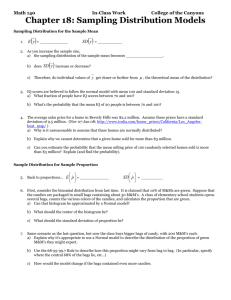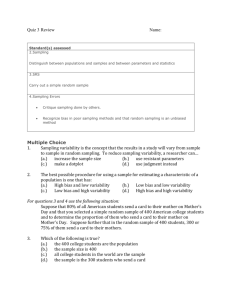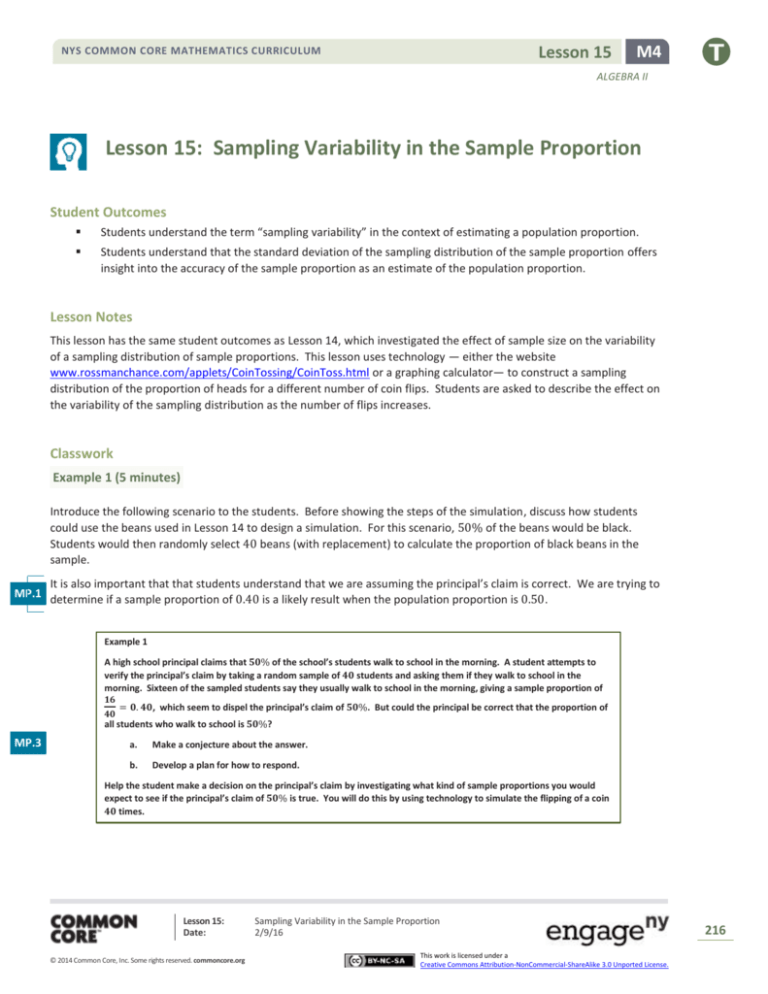
Lesson 15
NYS COMMON CORE MATHEMATICS CURRICULUM
M4
ALGEBRA II
Lesson 15: Sampling Variability in the Sample Proportion
Student Outcomes
Students understand the term “sampling variability” in the context of estimating a population proportion.
Students understand that the standard deviation of the sampling distribution of the sample proportion offers
insight into the accuracy of the sample proportion as an estimate of the population proportion.
Lesson Notes
This lesson has the same student outcomes as Lesson 14, which investigated the effect of sample size on the variability
of a sampling distribution of sample proportions. This lesson uses technology — either the website
www.rossmanchance.com/applets/CoinTossing/CoinToss.html or a graphing calculator— to construct a sampling
distribution of the proportion of heads for a different number of coin flips. Students are asked to describe the effect on
the variability of the sampling distribution as the number of flips increases.
Classwork
Example 1 (5 minutes)
Introduce the following scenario to the students. Before showing the steps of the simulation, discuss how students
could use the beans used in Lesson 14 to design a simulation. For this scenario, 50% of the beans would be black.
Students would then randomly select 40 beans (with replacement) to calculate the proportion of black beans in the
sample.
MP.1
It is also important that that students understand that we are assuming the principal’s claim is correct. We are trying to
determine if a sample proportion of 0.40 is a likely result when the population proportion is 0.50.
Example 1
A high school principal claims that 𝟓𝟎% of the school’s students walk to school in the morning. A student attempts to
verify the principal’s claim by taking a random sample of 𝟒𝟎 students and asking them if they walk to school in the
morning. Sixteen of the sampled students say they usually walk to school in the morning, giving a sample proportion of
𝟏𝟔
𝟒𝟎
= 𝟎. 𝟒𝟎, which seem to dispel the principal’s claim of 𝟓𝟎%. But could the principal be correct that the proportion of
all students who walk to school is 𝟓𝟎%?
MP.3
a.
Make a conjecture about the answer.
b.
Develop a plan for how to respond.
Help the student make a decision on the principal’s claim by investigating what kind of sample proportions you would
expect to see if the principal’s claim of 𝟓𝟎% is true. You will do this by using technology to simulate the flipping of a coin
𝟒𝟎 times.
Lesson 15:
Date:
© 2014 Common Core, Inc. Some rights reserved. commoncore.org
Sampling Variability in the Sample Proportion
2/9/16
This work is licensed under a
Creative Commons Attribution-NonCommercial-ShareAlike 3.0 Unported License.
216
Lesson 15
NYS COMMON CORE MATHEMATICS CURRICULUM
M4
ALGEBRA II
At this point, teachers may choose to explain how to use technology to perform the simulation. Depending on available
technology, students can use either a graphing calculator or a coin-tossing applet to perform simulations. (Note: Using
the applet may save time during the lesson, allowing opportunities for more class discussion.)
Using the coin tossing applet at the website:
1.
2.
Use the Coin Tossing Simulation –
Rossman/Chance Applet
Collection
For this example: enter 0.5 for
the probability of heads, 40 for
the number of tosses, and 1 for
the number of repetitions. Then
click on “Toss Coins.”
Go to: www.rossmanchance.com/applets/CoinTossing/CoinToss.html
Using a TI-84 Graphing Calculator:
Note: The following steps show how to use a TI-84
Graphing Calculator to simulate the flipping of a coin 40
times and then to calculate the sample proportion.
1.
Select MATH and highlight <PRB>
Lesson 15:
Date:
© 2014 Common Core, Inc. Some rights reserved. commoncore.org
Sampling Variability in the Sample Proportion
2/9/16
This work is licensed under a
Creative Commons Attribution-NonCommercial-ShareAlike 3.0 Unported License.
217
Lesson 15
NYS COMMON CORE MATHEMATICS CURRICULUM
M4
ALGEBRA II
2.
Choose: 7 RandBin(
3.
Input: RandBin(40,0.5)/40
4.
Press ENTER
In this example, the 0.525 is the proportion of heads that
were observed in the simulated flip of 40 coins.
Exploratory Challenge 1/Exercises 1–9 (15 minutes)
Students should work independently or in pairs on Exercises 1–3. As the students report their proportions of heads,
enter the reported proportions into a list if you are using a graphing calculator or into a list using computer graphing
software. Once all of the students have reported two sample proportions, construct a graph (histogram or dot plot) of
the class data. Students should work on Exercises 4–9 in groups. Discuss answers as a class.
Even though each student could construct their own sampling distribution, in this first example, each student is
generating just two sample proportions of heads. This way it mirrors what was done in Lesson 14. The sampling
distribution is constructed using sample proportions from the entire class.
Lesson 15:
Date:
© 2014 Common Core, Inc. Some rights reserved. commoncore.org
Sampling Variability in the Sample Proportion
2/9/16
This work is licensed under a
Creative Commons Attribution-NonCommercial-ShareAlike 3.0 Unported License.
218
Lesson 15
NYS COMMON CORE MATHEMATICS CURRICULUM
M4
ALGEBRA II
Exploratory Challenge 1/Exercises 1–9
In Exercises 1–9, students should assume that the principal is correct that 𝟓𝟎% of the population of students walk to
school. Designate heads to represent a student who walks to school.
1.
Simulate 𝟒𝟎 flips of a fair coin. Record your observations in the space below.
Answers will vary . Sample response:
T T T H H H T H H H T T T H T T H H H
H T H H T H T H T T H T T T H T H T T
T T
2.
What is the sample proportion of heads in your sample of 𝟒𝟎? Report this value to your teacher.
Answers will vary. Sample response:
3.
𝟏𝟖
𝟒𝟎
= 𝟎. 𝟒𝟓.
Repeat Exercises 1 and 2 to obtain a second sample of 𝟒𝟎 coin flips.
Answers will vary.
Your teacher will display a graph of all the students’ sample proportions of heads.
Note: The following is an example of a sampling distribution of sample proportions of heads in 𝟒𝟎 flips of a coin.
4.
Describe the shape of the distribution.
Answers will vary. The shape of the distribution shown above is slightly skewed.
5.
What was the smallest sample proportion observed?
Answers will vary. In the sample graph, 𝟎. 𝟐𝟓.
6.
What was the largest sample proportion observed?
Answers will vary. In the sample graph, 𝟎. 𝟔𝟓.
7.
Estimate the center of the distribution of sample proportions.
Answers will vary. In the sample graph, about 𝟎. 𝟓𝟎.
Your teacher will report the mean and standard deviation of the sampling distribution created by the class.
Answers will vary. The mean will be approximately 𝟎. 𝟓, and the standard deviation will be approximately 𝟎. 𝟎𝟕𝟗. From
the sample graph, the mean is 𝟎. 𝟒𝟗𝟑, and the standard deviation is 𝟎. 𝟎𝟖𝟓.
Lesson 15:
Date:
© 2014 Common Core, Inc. Some rights reserved. commoncore.org
Sampling Variability in the Sample Proportion
2/9/16
This work is licensed under a
Creative Commons Attribution-NonCommercial-ShareAlike 3.0 Unported License.
219
Lesson 15
NYS COMMON CORE MATHEMATICS CURRICULUM
M4
ALGEBRA II
8.
How does the mean of the sampling distribution compare with the population proportion of 𝟎. 𝟓𝟎?
Answers will vary. From the sample response, the population proportion of 𝟎. 𝟓𝟎 is very close to the mean of the
sampling distribution.
9.
Recall that a student took a random sample of 𝟒𝟎 students and found that the sample proportion of students who
walk to school was 𝟎. 𝟒𝟎. Would this have been a surprising result if the actual population proportion were 𝟎. 𝟓𝟎 as
the principal claims?
Answers will vary. Based on the sample responses, the value of 𝟎. 𝟒𝟎 is about one standard deviation from the
mean. There were quite a few samples in the simulation that resulted in sample proportions that were 𝟎. 𝟒𝟎 or
smaller. Hence, a value of 𝟎. 𝟒𝟎 would not be a surprising result if the population was 𝟎. 𝟓𝟎.
Example 2 (3minutes): Sampling Variability
Give students a moment to think, write, and/or speak about the question posed in the example.
Example 2: Sampling Variability
MP.3
What do you think would happen to the sampling distribution you constructed in the previous exercises had everyone in
class taken a random sample of size 𝟖𝟎 instead of 𝟒𝟎? Justify your answer. This will be investigated in the following
exercises.
Answers will vary. The results would be more accurate because there are more samples.
Now explain how students can generate their own sampling distributions using technology. The steps are slightly
different than before as students are now performing the simulation 40 times. Again, teachers should consider using
the applet in order to save time.
Using the Coin Tossing Applet at the Website:
Go to: www.rossmanchance.com/applets/CoinTossing/CoinToss.html
1.
Use the Coin Tossing Simulation –
Rossman/Chance Applet Collection
2.
For this example, enter 0.5 for the
probability of heads, 80 for the
number of tosses, and 40 for the
number of repetitions. Also check the
box proportion of heads and the box
for summary statistics.
Lesson 15:
Date:
© 2014 Common Core, Inc. Some rights reserved. commoncore.org
Sampling Variability in the Sample Proportion
2/9/16
This work is licensed under a
Creative Commons Attribution-NonCommercial-ShareAlike 3.0 Unported License.
220
Lesson 15
NYS COMMON CORE MATHEMATICS CURRICULUM
M4
ALGEBRA II
Using a TI-84 Graphing Calculator:
Note: The following steps show how to use a TI-84
Graphing Calculator to simulate the flipping of a coin 80
times to calculate the sample proportion, repeating the
process for a total of 40 times.
1.
Select MATH and highlight <PRB>
2.
Choose: 7 RandBin(
3.
Input: RandBin(80,0.5,40)/80→L1
Use the RandBin operation and input 80 for the
sample size, 0.5 for the population proportion, divide
by 80, store the results in L1, and then repeat 40
times.
Lesson 15:
Date:
© 2014 Common Core, Inc. Some rights reserved. commoncore.org
Sampling Variability in the Sample Proportion
2/9/16
This work is licensed under a
Creative Commons Attribution-NonCommercial-ShareAlike 3.0 Unported License.
221
Lesson 15
NYS COMMON CORE MATHEMATICS CURRICULUM
M4
ALGEBRA II
4.
Press ENTER and view the results in L1.
To view the relevant statistics, go to the STAT menu
and highlight <CALC>.
Choose option 1: 1–Var Stats.
5.
Students may also choose to view a histogram of the
sample proportions in L1.
Go to STAT PLOT. <2ND> and <Y=>
Make sure Plot 1 is turned on, and highlight the
histogram.
The following window is useful in viewing the
histogram.
Exploratory Challenge 2/Exercises 10–22 (15 minutes)
MP.5 In this set of exercises, students use technology to carry out simulations in order to study sampling variability. Students
should work independently or in pairs on Exercises 10–22.
Exploratory Challenge 2/Exercises 10–22
10. Use technology and simulate 𝟖𝟎 coin flips. Calculate the proportion of heads. Record your results in the space
below.
Answers will vary. Sample response:
Lesson 15:
Date:
© 2014 Common Core, Inc. Some rights reserved. commoncore.org
𝟑𝟗
𝟖𝟎
= 𝟎. 𝟒𝟖𝟕𝟓.
Sampling Variability in the Sample Proportion
2/9/16
This work is licensed under a
Creative Commons Attribution-NonCommercial-ShareAlike 3.0 Unported License.
222
Lesson 15
NYS COMMON CORE MATHEMATICS CURRICULUM
M4
ALGEBRA II
11. Repeat flipping a coin 𝟖𝟎 times until you have recorded a total of 𝟒𝟎 sample proportions.
Answers will vary. See Exercise 12 for a dot plot of the sampling distribution of the proportion of heads in 𝟖𝟎 flips of
a coin.
12. Construct a dot plot of the 𝟒𝟎 sample proportions.
13. Describe the shape of the distribution.
Answers will vary. From the sample response, the distribution is symmetric and mound shaped.
14. What was the smallest proportion of heads observed?
Answers will vary. From the sample response, 𝟎. 𝟑𝟗.
15. What was the largest proportion of heads observed?
Answers will vary. From the sample response, 𝟎. 𝟔𝟑.
16. Using technology, find the mean and standard deviation of the distribution of sample proportions.
Answers will vary. The mean will be approximately 𝟎. 𝟓, and the standard deviation will be approximately 𝟎. 𝟎𝟓𝟓.
In the example above, the mean = 𝟎. 𝟓𝟎𝟖 , and the standard deviation = 𝟎. 𝟎𝟔𝟏.
17. Compare your results with the others in your group. Did you have similar means and standard deviations?
Answers will vary. All the groups should have similar means and standard deviations.
18. How does the mean of the sampling distribution based on 𝟒𝟎 simulated flips of a coin (Exercise 1) compare to the
mean of the sampling distribution based on 𝟖𝟎 simulated coin flips?
Both of the means will be approximately equal to 𝟎. 𝟓𝟎.
19. Describe what happened to the sampling variability (standard deviation) of the distribution of sample proportions
as the number of simulated coin flips increased from 𝟒𝟎 to 𝟖𝟎.
The standard deviation decreased as the number of coin flips went from 𝟒𝟎 to 𝟖𝟎.
20. What do you think would happen to the variability (standard deviation) of the distribution of sample proportions if
the sample size for each sample were 𝟐𝟎𝟎 instead of 𝟖𝟎? Explain.
The standard deviation will decrease as the sample size increases.
Lesson 15:
Date:
© 2014 Common Core, Inc. Some rights reserved. commoncore.org
Sampling Variability in the Sample Proportion
2/9/16
This work is licensed under a
Creative Commons Attribution-NonCommercial-ShareAlike 3.0 Unported License.
223
Lesson 15
NYS COMMON CORE MATHEMATICS CURRICULUM
M4
ALGEBRA II
21. Recall that a student took a random sample of 𝟒𝟎 students and found that the sample proportion of students who
walk to school was 𝟎. 𝟒𝟎. If the student had taken a random sample of 𝟖𝟎 students instead of 𝟒𝟎, would this have
been a surprising result if the actual population proportion was 𝟎. 𝟓𝟎 as the principal claims?
Answers will vary. Generally this would be a surprising result. The value of 𝟎. 𝟒𝟎 is now about two standard
deviations from the mean. Only two of the 𝟒𝟎 simulated samples resulted in a sample proportion of 𝟎. 𝟒𝟎 or
smaller. A sample proportion of 𝟎. 𝟒𝟎 would be a fairly surprising result.
22. What do you think would happen to the sampling distribution you constructed in the previous exercises if everyone
in class took a random sample of size 80 instead of 40? Justify your answer.
MP.3
Answers will vary. The more samples, the more accurate the simulation will be because the standard deviation
decreases as sample size increases.
Closing (2 minutes)
Ask students to summarize the main ideas of the lesson in writing or with a neighbor. Use this as an
opportunity to informally assess comprehension of the lesson. The Lesson Summary below offers some
important ideas that should be included.
Lesson Summary
The sampling distribution of the sample proportion can be approximated by a graph of the sample proportions for
many different random samples. The mean of the sample proportions will be approximately equal to the value of
the population proportion.
As the sample size increases, the sampling variability in the sample proportion decreases – the standard deviation
of the sample proportions decreases.
Exit Ticket (5 minutes)
Lesson 15:
Date:
© 2014 Common Core, Inc. Some rights reserved. commoncore.org
Sampling Variability in the Sample Proportion
2/9/16
This work is licensed under a
Creative Commons Attribution-NonCommercial-ShareAlike 3.0 Unported License.
224
Lesson 15
NYS COMMON CORE MATHEMATICS CURRICULUM
M4
ALGEBRA II
Name
Date
Lesson 15: Sampling Variability in the Sample Proportion
Exit Ticket
Below are three dot plots of the proportion of tails in 20, 60, or 120 simulated flips of a coin. The mean and standard
deviation of the sample proportions are also shown for each of the three dot plots. Match each dot plot with the
appropriate number of flips. Clearly explain how you matched the plots with the number of simulated flips.
Dot Plot 1
Mean = 0.502
Standard deviation = 0.046
Sample Size:_________
Explain:
Dot Plot 2
Mean = 0.518
Standard deviation = 0.064
Sample Size:_________
Explain:
Lesson 15:
Date:
© 2014 Common Core, Inc. Some rights reserved. commoncore.org
Sampling Variability in the Sample Proportion
2/9/16
This work is licensed under a
Creative Commons Attribution-NonCommercial-ShareAlike 3.0 Unported License.
225
Lesson 15
NYS COMMON CORE MATHEMATICS CURRICULUM
M4
ALGEBRA II
Dot Plot 3
Mean = 0.498
Standard deviation = 0.110
Sample Size:_________
Explain:
Lesson 15:
Date:
© 2014 Common Core, Inc. Some rights reserved. commoncore.org
Sampling Variability in the Sample Proportion
2/9/16
This work is licensed under a
Creative Commons Attribution-NonCommercial-ShareAlike 3.0 Unported License.
226
Lesson 15
NYS COMMON CORE MATHEMATICS CURRICULUM
M4
ALGEBRA II
Exit Ticket Sample Solutions
Below are three dot plots of the proportion of tails in 𝟐𝟎, 𝟔𝟎, or 𝟏𝟐𝟎 simulated flips of a coin. The mean and standard
deviation of the sample proportions are also shown for each of the three dot plots. Match each dot plot with the
appropriate number of flips. Clearly explain how you matched the plots with the number of simulated flips.
Dot Plot 1
Mean = 𝟎. 𝟓𝟎𝟐
Standard deviation = 𝟎. 𝟎𝟒𝟔
Sample Size: 𝟏𝟐𝟎 flips of the coin
Dot Plot 2
Mean = 𝟎. 𝟓𝟏𝟖
Standard deviation = 𝟎. 𝟎𝟔𝟒
Sample Size: 𝟔𝟎 flips of the coin
Dot Plot 3
Mean = 𝟎. 𝟒𝟗𝟖
Standard deviation = 𝟎. 𝟏𝟏𝟎
Sample Size: 𝟐𝟎 flips of the coin
Lesson 15:
Date:
© 2014 Common Core, Inc. Some rights reserved. commoncore.org
Explain: As the number of flips
increases, the standard deviation
decreases. The sampling
distribution based on 𝟏𝟐𝟎 flips has
the smallest standard deviation.
Explain: As sampling size increases,
the standard deviation decreases.
Because this sample size falls
between the other two, its
standard deviation will be between
the standard deviations of the
other sample sizes.
Explain: This standard deviation is
the largest, which means that the
sample size must be the smallest.
Sampling Variability in the Sample Proportion
2/9/16
This work is licensed under a
Creative Commons Attribution-NonCommercial-ShareAlike 3.0 Unported License.
227
Lesson 15
NYS COMMON CORE MATHEMATICS CURRICULUM
M4
ALGEBRA II
Problem Set Sample Solutions
1.
A student conducted a simulation of 𝟑𝟎 coin flips. Below is a dot plot of the sampling distribution of the proportion
of heads. This sampling distribution has a mean of 𝟎. 𝟓𝟏 and a standard deviation of 𝟎. 𝟎𝟗.
a.
Describe the shape of the distribution.
Approximately symmetric. Some students may think that the distribution is slightly skewed to the left.
b.
Describe what would have happened to the mean and the standard deviation of the sampling distribution of
the sample proportions if the student had flipped a coin 𝟓𝟎 times, calculated the proportion of heads, and
then repeated this process for a total of 𝟑𝟎 times.
The mean would be approximately equal to 𝟎. 𝟓𝟏, and the standard deviation would be less than 𝟎. 𝟎𝟗.
2.
What effect does increasing the sample size have on the mean of the sampling distribution?
Increasing the sample size does not affect the mean of the sampling distribution. The mean of the sampling
distribution is approximately equal to the population mean for any sample size.
3.
What effect does increasing the sample size have on the standard deviation of the sampling distribution?
Increasing the sample size decreases the standard deviation of the sampling distribution.
4.
A student wanted to decide whether or not a particular coin was fair (i.e., the probability of flipping a head is 𝟎. 𝟓).
She flipped the coin 𝟐𝟎 times, calculated the proportion of heads, and repeated this process a total of 𝟒𝟎 times.
Below is the sampling distribution of sample proportions of heads. The mean and standard deviation of the
sampling distribution is 𝟎. 𝟑𝟕𝟗 and 𝟎. 𝟎𝟗𝟏. Do you think this was a fair coin? Why or why not?
If the coin was fair, the sampling distribution should be centered at about 𝟎. 𝟓𝟎. Here, the sampling distribution is
centered pretty far to the left of 𝟎. 𝟓𝟎. Hence, it is unlikely that the probability of heads for this coin would be 𝟎. 𝟓𝟎.
5.
The same student flipped the coin 𝟏𝟎𝟎 times, calculated the proportion of heads, and repeated this process a total
of 𝟒𝟎 times. Below is the sampling distribution of sample proportions of heads. The mean and standard deviation
of the sampling distribution is 𝟎. 𝟒𝟎𝟓 and 𝟎. 𝟎𝟒𝟔. Do you think this was a fair coin? Why or why not?
If the coin was fair, the sampling distribution should be centered at about 𝟎. 𝟓𝟎. Here, the sampling distribution is
centered pretty far to the left of 𝟎. 𝟓𝟎. Hence, it is unlikely that the probability of heads for this coin would be 𝟎. 𝟓𝟎.
Lesson 15:
Date:
© 2014 Common Core, Inc. Some rights reserved. commoncore.org
Sampling Variability in the Sample Proportion
2/9/16
This work is licensed under a
Creative Commons Attribution-NonCommercial-ShareAlike 3.0 Unported License.
228


